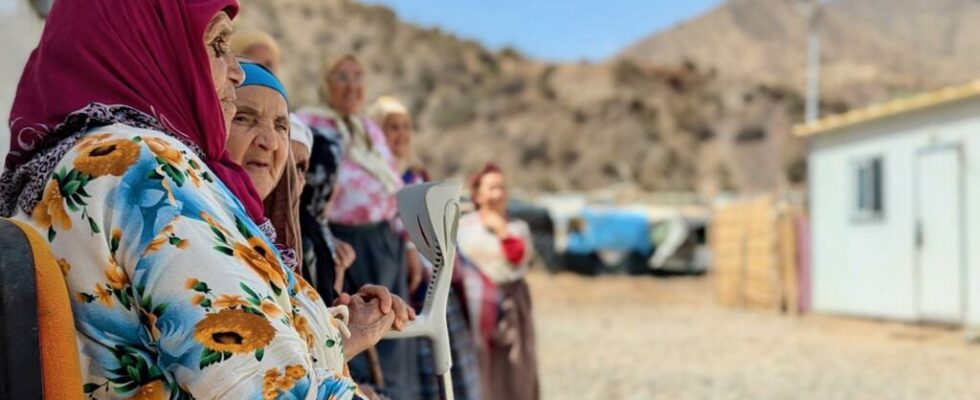In Morocco, faced with the scale of the destruction caused by the earthquake that struck just one year ago in the province of Al Haouz, the authorities have set up an ambitious program to replace or rehabilitate damaged buildings. But in the villages of the High Atlas, houses are slow to emerge from the ground.
4 min
On September 8, 2023, the Kingdom of Morocco was struck by a powerful earthquakethe deadliest the country has seen in more than 60 years. In the center of the country, the High Atlas region, where the epicenter is located, nearly 3,000 people were killed, more than 5,600 injured. Villages were almost completely wiped off the map in the Al Haouz provinceNearly 60,000 homes were damaged or destroyed.
The task is immense for the Moroccan state, which has decided to support the most affected families. Those whose main residence is in the disaster area have started to receive aid of 80,000 dirhams, or just over 7,000 euros, to renovate their partially damaged homes. Those whose homes were completely destroyed should receive 140,000 dirhams, approximately 13,000 euros, to rebuild their homes.
Multiple state aids
A monthly allowance of 2,500 dirhams, approximately 230 euros, was also paid to each household for one year. 64,000 families were able to benefit from it, according to figures published by the government in a press release, following, on Monday, September 2, the 11th meeting of the Interministerial Commission responsible for the deployment of the reconstruction and development program for disaster areas. Nearly 50,000 housing units are under construction, the document states. Nearly 1,000 families have completed their work. Reconstruction is progressing.
On the National Road 7, which connects Marrakech to the villages in the epicenter area, trucks filled with concrete blocks come and go. The entire region is a huge construction site. Demand is so high that there are not enough building materials. There is also a shortage of labor. Many workers come from elsewhere. Costs have skyrocketed, says a contractor from Beni Mellal, 300 kilometers away. Traffic remains difficult in this mountainous and landlocked region. The National Road 7 does not make travel easy. The road is currently being rebuilt and is bad for several kilometers.
Prefabricated and tents
In the small village of Amesguen, perched at an altitude of 1,000 metres, the inhabitants still live in prefabricated buildings, a hundred metres from their collapsed houses. Living conditions are harsh. This summer, the air was stifling in these light structures, without insulation and exposed to the sun. The installation of these prefabricated buildings by associations six months ago has nevertheless marked an improvement. Before, we lived in tents. Life in a tent is difficult. Water gets in, we manage as best we can. Even if we put plastic, the water ends up getting in. ” explains Abderrahim, a young man from the village.
According to one of the oldest residents of Amesguen, who is in the process of rebuilding her house with financial aid from the State, some residents have not yet dug the foundations. We will be at peace when everyone has their own accommodation. ” she says in a small voice. But it could take time. Here, about ten families have not been compensated. There are profiles that do not fit into the administration’s boxes, like Yamina’s: ” My documents proving my identity were left in the rubble of my house, she says. It was my son who registered. He lives in Marrakech. So they refused to give us aid. »
Reconstruction takes time
The entrepreneur from Beni Mellal notes a lack of communication between citizens and government services. He is responsible for 70 construction sites in the epicenter area. The reconstruction program imposes strict formalities that, according to him, slow down the payment of subsidies. The construction sites are regularly inspected. Everyone works every day to finish as soon as possible “, assures Anas Basraoui, chief engineer of the equipment division in the province of Al Haouz (the most affected by the earthquake), member of the steering committee responsible for monitoring the post-earthquake reconstruction operation. ” These are time-consuming operations, but efforts have been made to achieve at least 50% of work completion before the end of the year in Al Haouz Province. »
While the scars of the disaster are still visible, with collapsed houses and official buildings, state services are slowly getting back up and running in Talat N’Yaacoub, 10 kilometers from the epicenter. After spending the last school year at the boarding school in Marrakech, the village’s middle and high school students will now be able to stay with their families.
Also listen toIn Morocco, a center for earthquake orphans has opened a year after the disaster
